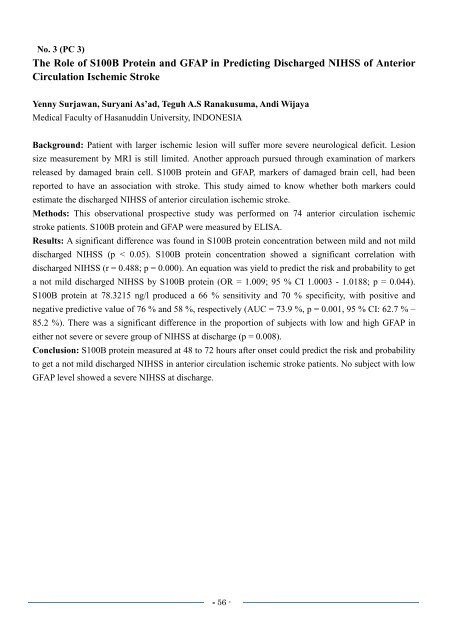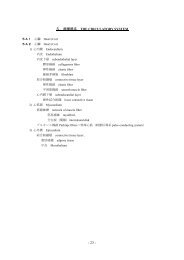Program / Abstract Book - KMU WWW3 Server for Education ...
Program / Abstract Book - KMU WWW3 Server for Education ...
Program / Abstract Book - KMU WWW3 Server for Education ...
You also want an ePaper? Increase the reach of your titles
YUMPU automatically turns print PDFs into web optimized ePapers that Google loves.
No. 3 (PC 3)<br />
The Role of S100B Protein and GFAP in Predicting Discharged NIHSS of Anterior<br />
Circulation Ischemic Stroke<br />
Yenny Surjawan, Suryani As’ad, Teguh A.S Ranakusuma, Andi Wijaya<br />
Medical Faculty of Hasanuddin University, INDONESIA<br />
Background: Patient with larger ischemic lesion will suffer more severe neurological deficit. Lesion<br />
size measurement by MRI is still limited. Another approach pursued through examination of markers<br />
released by damaged brain cell. S100B protein and GFAP, markers of damaged brain cell, had been<br />
reported to have an association with stroke. This study aimed to know whether both markers could<br />
estimate the discharged NIHSS of anterior circulation ischemic stroke.<br />
Methods: This observational prospective study was per<strong>for</strong>med on 74 anterior circulation ischemic<br />
stroke patients. S100B protein and GFAP were measured by ELISA.<br />
Results: A significant difference was found in S100B protein concentration between mild and not mild<br />
discharged NIHSS (p < 0.05). S100B protein concentration showed a significant correlation with<br />
discharged NIHSS (r = 0.488; p = 0.000). An equation was yield to predict the risk and probability to get<br />
a not mild discharged NIHSS by S100B protein (OR = 1.009; 95 % CI 1.0003 - 1.0188; p = 0.044).<br />
S100B protein at 78.3215 ng/l produced a 66 % sensitivity and 70 % specificity, with positive and<br />
negative predictive value of 76 % and 58 %, respectively (AUC = 73.9 %, p = 0.001, 95 % CI: 62.7 % –<br />
85.2 %). There was a significant difference in the proportion of subjects with low and high GFAP in<br />
either not severe or severe group of NIHSS at discharge (p = 0.008).<br />
Conclusion: S100B protein measured at 48 to 72 hours after onset could predict the risk and probability<br />
to get a not mild discharged NIHSS in anterior circulation ischemic stroke patients. No subject with low<br />
GFAP level showed a severe NIHSS at discharge.<br />
- 56 -



